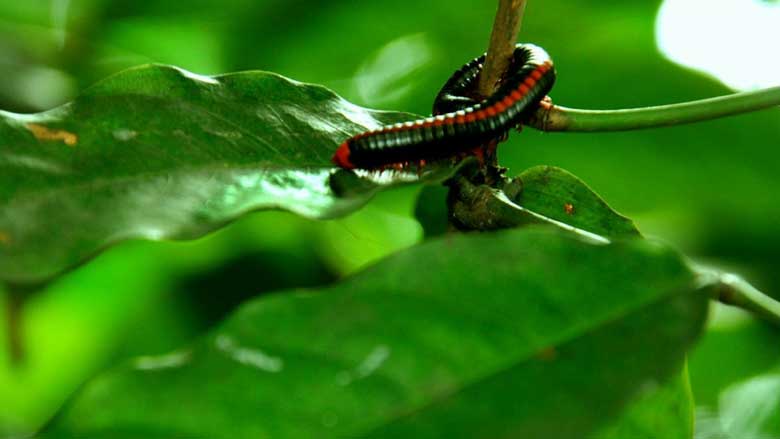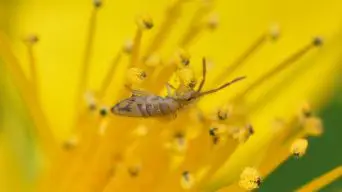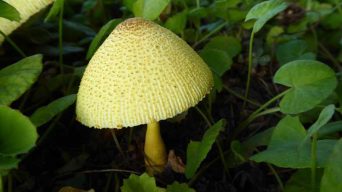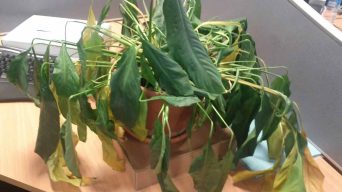If you’ve ever had a houseplant, you know that sooner or later, you’re going to have to deal with millipedes.
These little critters can be a nuisance, and they can also damage your plants.
Here’s an easy guide on how to get rid of millipedes in houseplants, so you can keep your plants healthy and happy.
What Are Millipedes?
Millipedes are small, segmented creatures with many legs – usually around 30.
They’re dark brown or black, and they like to live in damp, dark places.
Millipedes are not insects, but they are closely related to them.
They’re more closely related to crabs and shrimp than they are to bugs.
Millipedes are not harmful to humans, but they can damage plants by eating their roots or leaves.
They can also lay eggs in the soil, hatching and producing more millipedes.
Millipedes are often confused with centipedes, but they’re quite different.
Centipedes are shorter and thinner than millipedes, and they have fewer legs.
They’re also more aggressive and can bite humans if they feel threatened.
Neither centipedes nor millipedes are good for your plants, so it’s best to get rid of them both if you can.
Why Do I Have Millipedes in My Houseplants?
Millipedes usually find their way into your houseplants because they’re looking for a moist, dark place to hide.
They might come in through an open door or window or hitch a ride on something you’ve brought inside, like a pot or a piece of furniture.
Once they’re in, they’ll start to reproduce, and before you know it, you could have a millipede infestation on your hands.
Millipedes feed on decaying leaves, dead insects, and other organic matter.
If you have a lot of millipedes in your houseplants, there is likely some sort of food source that they’re attracted to.
You might have too much mulch around your plants, or there might be something decomposing in the potting soil.
They also like warm and humid places, so if you have a lot of houseplants, that could be another reason why they’re coming inside.
Are Millipedes Bad for Houseplants?
While millipedes aren’t dangerous to humans, they can damage your plants.
They usually do this by eating the roots or leaves of the plant, but they can also lay eggs in the soil.
The eggs will hatch, and the new millipedes will start to feed on your plants as well.
This can stress the plant and make it more susceptible to disease.
In severe cases, the plant might die.
If you have a millipede infestation, you’ll likely notice your plants wilting or looking unhealthy.
You might also see damaged leaves or stems, and you might notice that the millipedes are eating the roots of your plants.
If you see any of these signs, it’s essential to take action and get rid of the millipedes as soon as possible.
However, Millipedes can also be beneficial for your plants.
They help to aerate the soil and eat other pests that might damage your plants, like aphids or mites.
So, if you have a millipede infestation, you might consider keeping some of them around.
The problem with millipedes is that they can quickly become a nuisance.
They’ll reproduce quickly, and they can damage your plants if they’re not kept in check.
So, while they might be beneficial for your plants in small numbers, it’s best to get rid of them if you have too many.
How To Tell If You Have A Millipede Infestation
The first step in getting rid of millipedes is to figure out whether or not you have an infestation.
The easiest way to tell if you have millipedes is to look for them!
Check under rocks, leaves, and logs for these plant pests. You may also see them crawling around on the ground or your plants.
You may also tell that you have a millipede infestation if you see damage to your plants.
Millipedes can cause severe damage to plants, including eating the leaves, stems, and roots.
You can tell if your potted plant has been damaged by millipedes if you see chewed leaves or stems or if your plant is wilting or dying.
If you think you may have a millipede infestation, it’s essential to take action immediately.
These pests can quickly multiply and cause severe damage to your infested plant and home.
How To Get Rid of Millipedes in Houseplants
Indoor plants are a great way to spruce up your home and add some life to your space.
However, they can also be a breeding ground for pests like millipedes.
If you have millipedes in your houseplants, it’s important to take action and get rid of them as soon as possible.
Here are a few things you can do to get rid of millipedes in your houseplants:
Remove Them by Hand
One of the easiest ways to get rid of millipedes is to remove them by hand.
This can be a time-consuming process, but it’s the best way to ensure all the millipedes are gone.
Simply put on a pair of gloves and start picking the millipedes off of your plants.
Check under leaves and in the soil for any hiding millipedes.
Once you’ve removed all of the millipedes you can find, dispose of them properly.
You can put them in a sealed container and throw them away or release them outdoors.
If you choose to release them outdoors, make sure you do it far away from your home to prevent them from coming back.
Change the Soil
If you have millipedes in your houseplants, they’re likely coming from the soil.
To get rid of them, you’ll need to change the soil of your housplants.
Start by removing all of the plants from their pots.
Then, dispose of the old soil and replace it with fresh soil.
You can find sterile soil at your local gardening store.
Once you’ve replaced the soil, clean the pots before replanting your plants.
This will help to prevent the millipedes from coming back.
Use Diatomaceous Earth
Diatomaceous earth is a natural substance that can be used to kill houseplant pests.
It works by absorbing the oils and waxes that millipedes need to survive.
To use diatomaceous earth, simply sprinkle it around the base of your plants.
Be sure to cover the soil completely.
You can also add diatomaceous earth to the potting mix when repotting your plants.
Use Insecticidal Soap
Insecticidal soap is a safe and effective way to kill millipedes.
It works by breaking down the cell walls of the millipedes, causing them to dehydrate and die.
To use insecticidal soap, mix it with water according to the instructions on the label.
Then, spray it directly onto the millipedes and any other insects infesting your houseplants.
You may need to reapply insecticidal soap every few days until the infestation is gone.
Be sure to cover the millipedes completely and avoid getting the soap on your skin or in your eyes.
Use Neem Oil
Neem oil is a natural substance that can be used to kill millipedes.
It works by interfering with the millipedes’ ability to molt, eventually leading to death.
To use neem oil, mix 1 teaspoon of neem oil with 1 cup of water.
Then, put the mixture in a spray bottle and spritz it on the millipedes and the leaves of your plants.
Do this once a week until the millipedes are gone.
Be sure to avoid getting neem oil on your skin or your eyes.
Use Cayenne Pepper
Cayenne pepper is a natural substance that can be used to kill millipedes.
It works by irritating the millipedes’ skin, causing them to dehydrate and die.
To use cayenne pepper, mix equal parts of the pepper with water.
Then, use a spray bottle to apply the mixture to the leaves of your plants.
Reapply every few days until the millipedes are gone.
Set Up a Trap
One of the best ways to get rid of millipedes is to set up a trap.
You can use a few different types of traps, but one of the most effective is the sticky trap.
Sticky traps are made of a sticky substance that traps the millipedes when they walk across them.
To set up a sticky trap, simply place the trap near your plants and wait for the millipedes to walk across it.
Be sure to check the traps regularly and remove any millipedes that have been caught.
You can find sticky traps at your local hardware store.
Use Beneficial Nematodes
Beneficial nematodes are tiny parasitic worms that kill millipedes.
They enter the millipede’s body and release bacteria that eat away at the millipede from the inside, causing it to die.
To use beneficial nematodes, mix them with water according to the instructions on the package.
Then, pour the mixture into the soil around your plants.
The nematodes will then seek out and kill any millipedes in the area.
How To Prevent Millipedes in Houseplants
Keeping millipedes out of your houseplants is often easier than getting rid of them.
Here are a few tips to help you keep millipedes away:
- Remove any potential food sources. Millipedes are attracted to decaying matter, so remove any dead leaves or other organic debris from your plant pots.
- Remove any potential hiding places. Millipedes like to hide in dark, damp places. Remove any mulch or other materials from around your plants that could provide shelter for millipedes.
- Water your plants properly. Overwatering can lead to damp conditions that millipedes find attractive. Make sure to water your plants only as often as they need it.
- Make sure your pots have drainage holes. Millipedes need moisture to survive, so a well-drained potting mix will discourage them from taking up residence in your plants.
- Repot your plants regularly. This will help to get rid of any eggs that may have been deposited in the potting mix.
- Keep your plants healthy. Healthy plants are less attractive to millipedes and other houseplant pests.
Prevention is the key to keeping millipedes out of your houseplants.
By following these tips, you can help to keep your potted plants healthy and millipede-free.
Final Thoughts
Getting rid of millipedes in houseplants is not difficult, but it does require diligence and regular maintenance.
The best way to get rid of millipedes is to prevent them from getting into your potted plants in the first place.
By following the tips above, you can help to keep your plants healthy and millipede-free.







